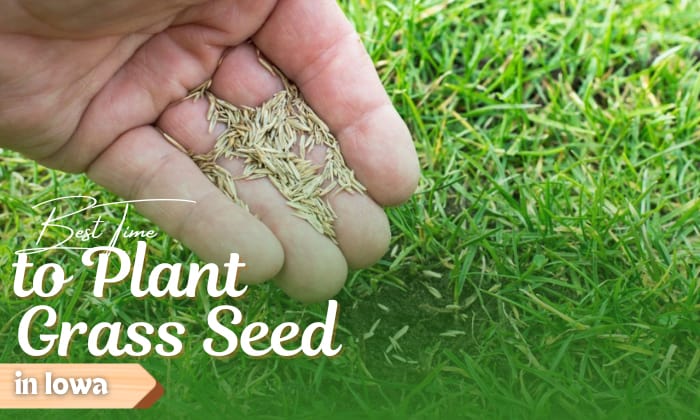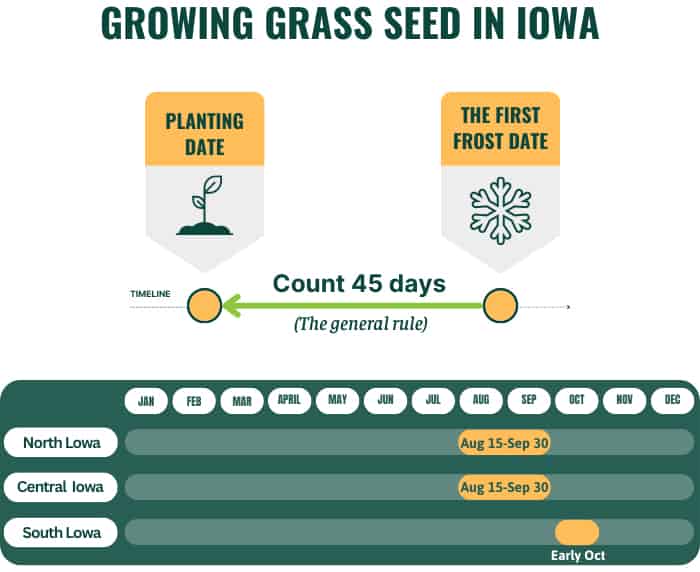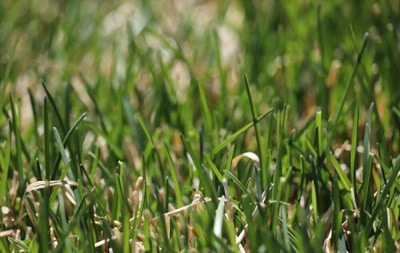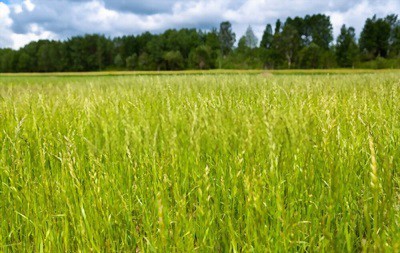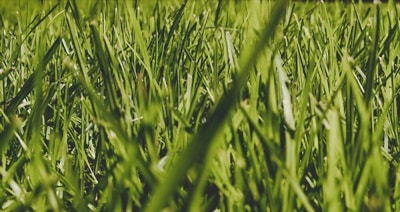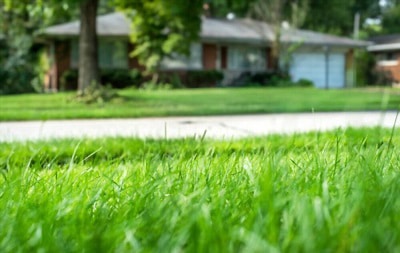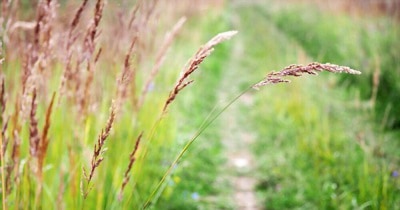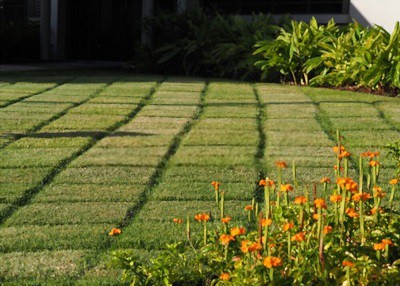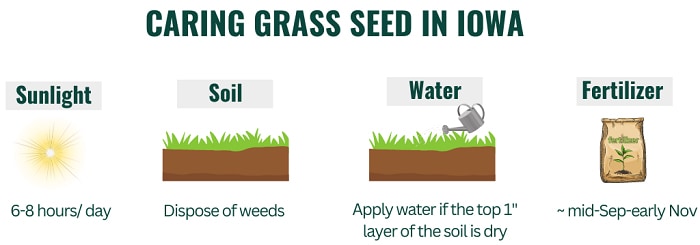Grass seed planting schedules vary per state, since factors such as seasons and soil temperatures should be considered. If you’re from Iowa, it’s important that you know the best time to plant grass seed in your area.
So, when to plant grass seed in Iowa? The best time to seed grass is in the fall in Iowa, specifically from August 15 to September 30, although the grass seeding season can go as late as October 15.
Want to know more? Simply read this article further!
Table of Contents
Best Time to Plant Grass Seed in Iowa
1. Early summer to mid-fall planting for cool-season lawns
August 15 to September 30 is the best time of year to start grass in Iowa’s northern and central parts. This is due to grass seedlings’ germination time and growth speed brought about by ideal soil, day and nighttime temperatures.
You can also perform fall grass seeding in early October in the southern parts of the state, so a bit later than other regions.
Take note that if you are not from these areas, your chances of establishing a successful lawn lessen as each day in October passes by. The general rule is to plant 45 days before the first frost at the latest.
2. Late fall to early winter planting
If you desire lush green grass in the next succeeding spring season, you can also try your luck with dormant seeding in Iowa from November 15 to December 14.
However, this process is tricky, since you have a lot of factors to consider, such as germination time, cold winter temperatures, when to put grass seed down, and soil conditions.
Grass seeds can die in the cold, for example, or germinate too early and then get snuffed out due to extreme snow. If you opt for dormant seeding, wait until temperatures remain under 50 degrees and use an interseeder for planting.
3. Spring Iowa planting for warm-season grass
Luckily, you can also seed lawn grass for early spring in Iowa. For warm grass seed species, you would have to plant from June 1 to 14 or after the last frost.
This is why spring grass seed timing can begin as early as March. Although spring is the next best time to lay grass seed in Iowa, it usually brings more weed problems compared to fall gardening. One way to mitigate this issue is to apply a pre-emergent herbicide before planting.
Read more: Best time to plant grass seed in Maryland, Wisconsin and other states.
Where Should I Plant Grass Seeds?
A soil pH of 6 to 7.5 generally works best. You can use lime to increase the pH and peat moss or sulfur to lower it. A layer of sand and compost over the planting area will also increase the soil’s organic content, reduce thatch, and allow you to use less fertilizer.
Best Grass Seed for Iowa
Refer to the table below to know the best Iowa grass seed varieties and their characteristics:
1. Kentucky Bluegrass
- Texture: Medium
- Color: Dark green
- Spread: Rhizomes
- Optimal Soil Temp: 50°F to 65°F
- Days to Germinate: 14 to 30 days
- Tolerance: Good drought and cold tolerance, poor shade tolerance
2. Perennial Ryegrass
- Texture: Medium to coarse
- Color: Dark green
- Spread: Tillers
- Optimal Soil Temperature: 68°F to 77°F
- Days to Germinate: 7 to 14 days
- Tolerance: Moderate shade tolerance, good drought and cold tolerance
3. Buffalograss
- Texture: Fine
- Color: Blue to grayish green
- Spread: Stolons and rhizomes
- Optimal Soil Temperature: 55°F to 80°F
- Days to Germinate: 14 to 21 days
- Tolerance: High drought and cold tolerance, poor shade tolerance
4. Tall Fescue
- Texture: Coarse
- Color: Medium to dark green
- Spread: Tillers or rhizomes
- Optimal Soil Temperature: 60°F to 65°F
- Days to Germinate: 7 to 21 days
- Tolerance: High drought tolerance, good shade and cold tolerance
5. Fine Fescue
- Texture: Fine
- Color: Medium to dark green
- Spread: Rhizomes or bunches
- Optimal Soil Temperature: 50°F to 65°F
- Days to Germinate: 5 to 12 days
- Tolerance: Good drought and cold tolerance, high shade tolerance
6. Zoysiagrass
- Texture: Medium
- Color: Dark green
- Spread: Stolons and rhizomes
- Optimal Soil Temperature: 65°F to 70°F
- Days to Germinate: 14 to 24 days
- Tolerance: High cold and drought tolerance, good shade tolerance
Factors Affecting the Success of Planting Grass Seed in Iowa
1. Sunlight
Although some species and cultivars may tolerate shade, grass seeds generally require a minimum of 6 hours of direct sunlight daily, but if you really want to achieve that lush green color, going for 8 hours or more a day is the key.
2. Soil
Performing a soil test and supplementing any lacking nutrients as shown in the results is important and can significantly affect the establishment of your grass seed. Remove and dispose of any weeds and other vegetation.
Afterwards, firm the soil by using a packer or roller. Soil firmness is essential as it affects how deep you can seed your grass.
3. Water
Whether you have seeded a new or existing lawn, the soil should remain consistently moist but not wet. Grass seeds are vulnerable to injuries brought about by extreme heat or drought. Apply water if the top 1-inch layer of the soil is dry.
4. Fertilizer
Apply fertilizer based on the prescribed results of your soil test prior to planting grass seeds. This application will be enough for the next 6 to 8 weeks of turfgrass growth, but you can also make repeat applications depending on when you have sown your grass.
Knowing when to apply fertilizer is essential. Specifically, if you follow a fall planting schedule, fertilize your lawn in spring or fall around mid-September to early November.
5. Mowing
Begin mowing your lawn when the turf reaches a minimum of 2.5 inches in height. Depending on the environmental conditions, this takes place about 4 to 6 weeks after the seeds have been sown.
Here is a guide on the ideal height for the different grass types:
- Kentucky bluegrass: 2 to 3 inches
- Perennial ryegrass: 2 to 3 inches
- Buffalograss: 2 to 4 inches
- Tall fescue: 2 to 4 inches
- Fine fescue: 1.5 to 3 inches
- Zoysiagrass: 1 to 2.5 inches
Additionally, verticutting lawn grass can also positively affect your overall turfgrass health. Do this task during the growing season to remove thatch, then apply fertilizer afterwards.
Iowa Lawn Care Schedule
Here is a summary calendar to guide you in taking care of your lawn:
| Jan | Feb | Mar | Apr | May | Jun | Jul | Aug | Sep | Oct | Nov | Dec | |
| Mowing | ✓ | ✓ | ✓ | ✓ | ||||||||
| Fertilizer/herbicide | ✓ | ✓ | ✓ | |||||||||
| Patch/overseed | ✓ | ✓ | ||||||||||
| Plant seeds/sod | ✓ | ✓ | ||||||||||
| Water | ✓ | ✓ | ✓ | ✓ | ✓ |
How Do I Overseed My Lawn?
The following steps show how you can perform overseeding in Iowa:
- Perform a soil test and make any necessary amendments.
- Mow the existing turfgrass to eliminate competition for the new turf. The ideal height is around 1.5 to 2 inches.
- Begin sowing your choice of grass seed. Use a lawn spreader to evenly apply half of it in one direction and the remaining half in the opposite direction.
- Make sure there is adequate seed-to-soil contact to encourage germination by firming the seeds into the soil. You can use a metal rake or roller.
- Perform the same care and maintenance you would make when seeding a new lawn. Water immediately to help the grass establish, about two times a day for the first four days.
The best time to overseed in the state is basically the same as planting new turfgrass, which means it is sometime between August 15 to September 15.
Frequently Asked Questions
What happens if you seed your lawn too early?
Your lawn may have uneven patches of turfgrass as some seeds might germinate earlier or later than the others. Animals may also eat the seeds before they can grow.
How do I prepare my yard for grass seed?
This is done by raking, removing, and disposing of any debris in your yard, which may include stones, woods, sticks, old grass, and any large roots.
How long does grass seed take to grow fully?
Generally, if they are grown in optimal environmental conditions, seeds can begin germination within 8 to 10 days and reach maturity after 6 to 8 weeks.
What month is best to plant grass seed?
For cool-season grasses, this is around September, while warm-season grasses grow best when planted in March to July when the temperature is high (around 80 degrees).
When is a good time to start planting grass seed?
Start seeding your grass in the early morning. Make sure to check your weather forecast beforehand to see if you have a warm and sunny day ahead of you.
Conclusion
Hopefully by the end of this article, you now know when to plant grass seed in Iowa. One thing to remember is that timing—and choosing the appropriate grass seed type to plant–are highly essential factors to consider.
Additionally, you should also look out for various grass seed requirements such as sunlight, soil, water, fertilizer, and mowing to increase your chances of successfully establishing a lush green lawn come next season.

Hi, I am William – Floridayards’ digital content creator. My job is to find answers to all your concerns with thorough research and our team’s expert advice. I will also bring you honest reviews on the best products and equipment for raising your beautiful garden. Please look forward to our work!


